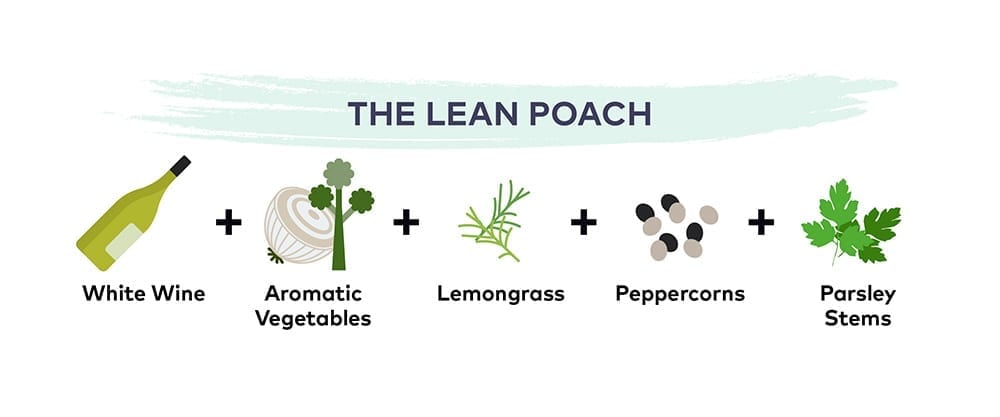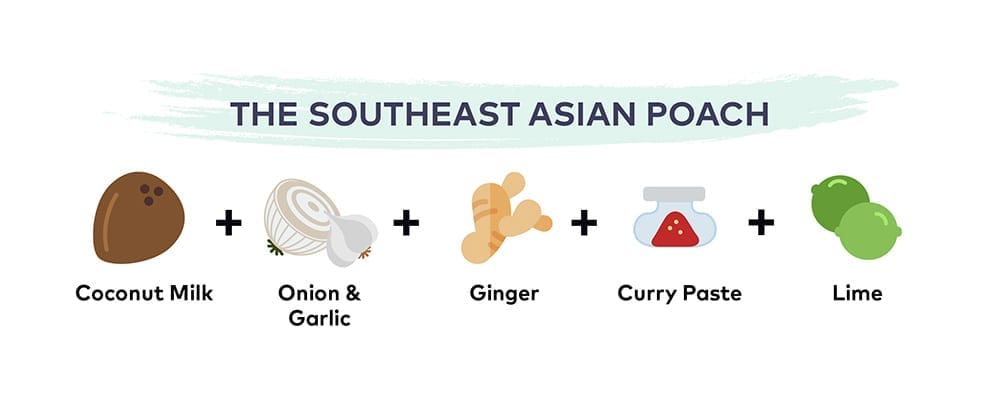Poaching is a simple yet delicious way of cooking fish that yields incredibly moist, flaky, and tender results. The gentle simmering action infuses the fish with flavor while keeping it succulent and juicy. However, not all fish are equally suited to poaching. The technique works best with certain types that can hold up well to the moist heat environment. So what fish can be poached to perfection?
In this comprehensive guide, we’ll explore the best fish varieties for poaching along with tips for choosing quality fish. You’ll learn how to poach fish to tender perfection and pick up flavorful poaching liquid ideas. We’ll also suggest tasty side dishes to serve alongside your poached fish. Follow this advice and you’ll be able to enjoy healthy, foolproof poached fish meals.
Understanding Poaching and Its Benefits
Poaching involves gently simmering fish in liquid at 160°F to 180°F until just cooked through This moist-heat method has numerous advantages
-
Retains moisture and nutrients better than dry cooking methods. Fish poaches in its own natural juices.
-
Yields exceptionally tender, flaky, succulent fish.
-
Allows subtle infusion of flavors from poaching liquid.
-
Requires minimal added fat compared to frying or sautéing. A healthy cooking technique.
-
Easy, hands-off method perfect for busy weeknights.
With the right fish choice and poaching approach, you can enjoy these benefits at home.
Best Fish for Poaching
The ideal fish for poaching has a few key characteristics:
Delicate, Flaky Texture
-
Fish like sole, tilapia, cod, flounder, and halibut have a delicate flesh that gently flakes off when poached.
-
Sturdier fish like tuna, salmon, and swordfish can also be poached but benefit from slightly higher heat.
Mild, Neutral Flavor
-
Fish like snapper, trout, catfish, and bass have a mild taste that allows other flavors to shine.
-
Stronger flavored fish like salmon and mackerel can be poached but pair better with boldly flavored poaching liquids.
Medium to Lean Fat Content
-
Fattier fish like salmon and trout add richness to a poach.
-
Leaner fish like tilapia and halibut cook up lighter.
-
Very lean fish can dry out, so poach carefully in well-flavored liquid.
Choosing Fresh, Quality Fish
No matter what type of fish you select, quality is vital for successful poaching. Look for:
-
Bright, clear eyes
-
Shiny, vibrant skin
-
Firm, resilient flesh
-
No darkening or drying around the edges
-
Little to no fishy odor
High-quality fresh or thawed frozen fish produce superior poaching results. Lower quality fish will cook up unevenly and may have an unpleasant taste.
Preparing Fish for Poaching
Proper prep is key before poaching:
-
If using whole fish, scale, gut, trim fins. Remove head/tail if desired.
-
Rinse fish under cold water and pat very dry with paper towels. Residual moisture can inhibit poaching.
-
Cut into portions if necessary. Even size pieces cook evenly.
-
Season fish lightly on both sides with salt, pepper, herbs, spices, or citrus zest.
-
Chill in fridge 30 min to 2 hours to allow seasoning to penetrate.
With prep complete, it’s time to poach!
Step-By-Step Guide to Poaching Fish
Follow these simple steps for perfect poached fish:
-
Choose a suitable poaching liquid such as water, broth, wine, milk, juice, dashi, etc. Add aromatics like lemon, herbs, garlic, ginger, etc.
-
Heat poaching liquid in a saucepan or poacher until barely simmering (160°F to 180°F). The liquid should quiver slightly but not have full bubbles breaking the surface.
-
Gently lower the fish into the liquid. Do not overcrowd the pan. Fish should be mostly submerged.
-
Poach fish uncovered at a bare simmer, turning once halfway through. Refer to a cooking time chart as a guide.
-
Check for doneness occasionally by flaking the flesh gently with a fork. Fish should be opaque throughout.
-
When just cooked, immediately transfer to a plate. Spoon over a little poaching liquid and cover to keep warm.
Follow these simple steps for tender poached fish bursting with flavor.
Poaching Liquid Suggestions
The poaching liquid provides key flavor and moisture. Tailor it to your chosen fish. Consider:
-
Water – use for mild flavored fish to highlight natural taste
-
Wine or vinegars – impart brightness for rich fish like salmon
-
Broths – chicken, fish, shrimp broth all add savory depth
-
Milk or half & half – enrich delicate white fish like cod
-
Juices – citrus, vegetable, or fruit juices lend balance
-
Dashi – Japanese stock seasoned with kombu and bonito
-
Coconut milk – perfect for poaching firmer fish in Thai dishes
Infuse liquids with aromatics like onions, carrots, celery, garlic, ginger, herbs, peppercorns, citrus zest, etc. Let flavors mingle before poaching fish.
Serving Suggestions for Poached Fish
Poached fish can be served in many appealing ways:
-
Drizzle with fresh lemon, herbs, and extra virgin olive oil
-
Top with sauces like hollandaise, beurre blanc, or salsa
-
Flake into salads, rice bowls, tacos, fish cakes, pasta dishes
-
Serve whole on a bed of Mediterranean vegetables or wilted greens
-
Pair with roasted potatoes, quinoa, or couscous to complete the meal
-
Garnish with crisp fresh vegetables like sugar snap peas, radish, fennel, etc.
A dash of acidity, texture, color, and brightness can take your poached fish to the next level.
Mouthwatering Poached Fish Recipes to Try
Here are some delicious recipes to showcase poached fish:
-
Coconut Poached Halibut with Lemongrass – Firmer fish stands up beautifully to the Thai-inspired spices and coconut milk.
-
Wine Poached Salmon – Salmon is stellar paired with the acidic brightness of white wine and aromatics.
-
Poached Tilapia Tacos with Pico de Gallo – Delicate tilapia tastes amazing tucked into a corn tortilla with zippy salsa.
-
Chardonnay Poached Cod with Lemon Butter – Smooth chardonnay and savory fish stock allow the cod’s sweetness to shine.
-
Poached Trout with Herb Vinaigrette – A classic French-style poached trout with a bright parsley and shallot dressing.
The possibilities are endless! Poaching truly allows the natural flavors of fish to shine through.

Poaching is perfect for when you want to make a sophisticated meal without making it complicated.
There are many different ways to poach fish, and in this post, we’re sharing our favorites. The easy method is to put fish in a liquid that is just barely simmering and let it cook slowly while soaking up all the flavors.
The Butter & Wine Poach
A butter poach is as decadent as it sounds. It’s also a great way to make lean white fish more tender. Wine, garlic, and thyme deepen the flavor but are subtle enough not to distract from the buttery taste.
Try It at Home: In a large saucepan over medium-low heat, melt 14 tablespoons of butter. Add ¼ cup of white wine, 1 crushed garlic clove, and 1 sprig of thyme. When the liquid is nearly simmering, add seasoned fish fillets and cook until opaque, 10 to 15 minutes.

Court bouillon is a quick-cooked broth that gets its flavor from wine and aromatics. It’s a great way to add flavor without adding a lot of calories, and it works with both lean and fatty fish.
Try It at Home: In a large pot, combine 5 cups water and 1 cup dry white wine. Two chopped celery stalks, one chopped leek, one small chopped onion, one crushed lemongrass stalk, one bay leaf, six black peppercorns, and three chopped parsley stems should be added. Simmer 15 minutes, then strain. Return strained liquid to pot or saucepan, add seasoned fish fillets, and simmer for 7-10 minutes.

Poaching Fish | Think & Cook like a Michelin Star Chef
What kind of fish should be poached?
A general rule is that lean fish are better poached in oil, fatty fish in something like broth or sake or wine or whatever. This, as with everything in this world, is a guideline, not dogma. Butter poached salmon is amazing, as is burbot poached in 7-Up, weirdly enough… Any good poached fish will:
What is poached fish?
Poached fish is a simple and delicious dish that can be prepared quickly and easily. Poaching is a good technique for cooking lean fish like tilapia, cod, sole, haddock, snapper, or halibut as well as fatty fish like salmon or trout.
What fish can be poached in oil?
When it comes to types of fish that can be poached in oil, the sky (or sea) is the limit. In general, the varieties best suited for oil poaching are meatier and oilier, such as tuna, swordfish, mahi mahi, mackerel, bluefish, salmon, halibut, and striped bass, says Bianca Piccillo, co-founder of sustainable seafood store Mermaid’s Garden.
How do you poach fish?
For the poaching liquid, we make a simple savory broth using water, white wine, lemon, and a few aromatics. This helps to infuse the fish with flavor instead of using a sauce. Here’s what you’ll need to make this perfectly poached fish dish: White wine – white wine adds dimension and is used to build flavor in the poaching liquid.
